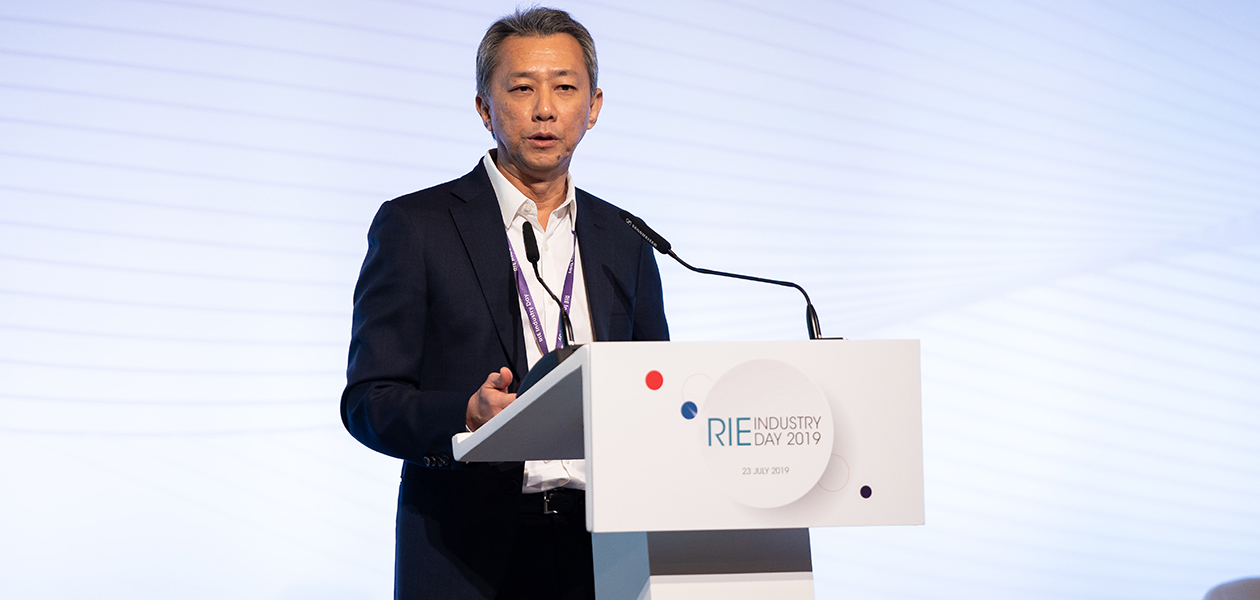At RIE Industry Day 2019, a panel of experts shared their insights on how businesses can effectively tap on partnerships with public research institutions to stay ahead of the curve in Industry 4.0.
First invented to pump water out of mines in the late 17th century, the steam engine became the hallmark of the first industrial revolution, a transformative period when factories emerged from what was a predominantly agrarian society. Following which, the harnessing of electricity and invention of electronics drove the second and third industrial revolutions respectively, with technological innovations again playing a pivotal role in phasing out outdated methods of production in favour of new, more efficient ones.
“Innovation and intellectual property will be even more critical going forward into the fourth industrial revolution. However, being good at innovation is getting harder and harder,” said Chia Song Hwee, president & chief operating officer of Temasek International, during his welcome address at RIE Industry Day 2019, an invite-only event organised to bring leaders from industry and research institutions together to generate ideas for potential collaborations. “For many companies, partnerships with public research institutions is the way forward.”
This year’s event was held in conjunction with an open innovation call launched by Temasek and supported IPI, where 25 solution providers were selected from 200 proposals for face-to-face meetings with companies such as CapitaLand and Sembcorp.
To boldly go
One of the conundrums confronting smaller companies is whether they should be putting in the time and money to adopt new technologies in the first place. “Investing in the enablers, like putting WiFi into a [chemical] plant, is pretty expensive. Most SMEs are focused on their existing business and trying to make ends meet,” said Goh Koon Eng, general manager at Chevron Singapore, during a panel discussion on Industry 4.0.
Moreover, while the costs can be readily tracked, the potential returns from investments into emerging technologies are uncertain and difficult to quantify, making it hard for companies to justify the expense.
“However, new technologies are going to hit us and transform the way we do business whether we like it or not. If we tried to calculate how much return we would get out of building the first car, we would still be riding horses now,” Goh quipped, encouraging companies to not get overly caught up with their calculations but instead develop a bold vision in terms of the problems they want to solve and what new value they want to create.
Innovating upwards and sideways
While solving day-to-day problems is important, companies stand to reap greater rewards by aiming for more ambitious targets. “We are already squeezing the last few ounces out of possible productivity gains… companies must now think about branching out and going into other markets with new products; that is what will take us to the next S curve,” said Dr Lim Keng Hui, executive director of the Institute of High Performance Computing (IHPC) at the Agency for Science, Technology and Research (A*STAR).
Sembcorp Marine is a case in point, he continued. By tapping on IHPC’s expertise in digital simulation and modelling, they compressed their product development lifecycle to introduce the first made-in-Singapore ship ballast water treatment system. “Sembcorp went on to win a R&D award, but more importantly, it allowed them to enter into a new market,” he added.
Although large corporations are traditionally the ones that are more risk taking, some smaller local companies are beginning to catch onto the trend as well, seeking out partnerships to push the market boundaries, Dr Lim observed.
A step-wise approach
As companies enter into different partnerships, it is important to bear in mind that adopting new technologies is a journey and not an overnight transformation, the panellists said. “If you just latch on to a buzzword, say 3D printing, and want to do it tomorrow, I don’t think that’s very realistic,” cautioned Dr Lim. “I always believe in more of a ‘crawl, walk, run’ approach.”
For instance, companies first need to build a pool of the right talent before they can effectively execute and leverage on emerging technologies. Training existing staff not only equips them with technical skills, but can also help to generate new ideas. “When we send our guys out for training by Singapore Polytechnic, they come back excited and bursting with more ideas than what we can absorb at the leadership level,” shared Goh.
Whether it is helping companies to break into new markets or train their staff, research institutions and institutes of higher learning like IHPC and Singapore Polytechnic offer a wealth of opportunities for innovation. By running open innovation calls to bring companies and public research institutes together, organisations like IPI are helping both sides take the first step towards collaboration.
“Ultimately, it is best to think about it as a journey that the public sector and private companies can undertake together, rather than expect to jump into Industry 4.0 straight away,” Dr Lim concluded.

